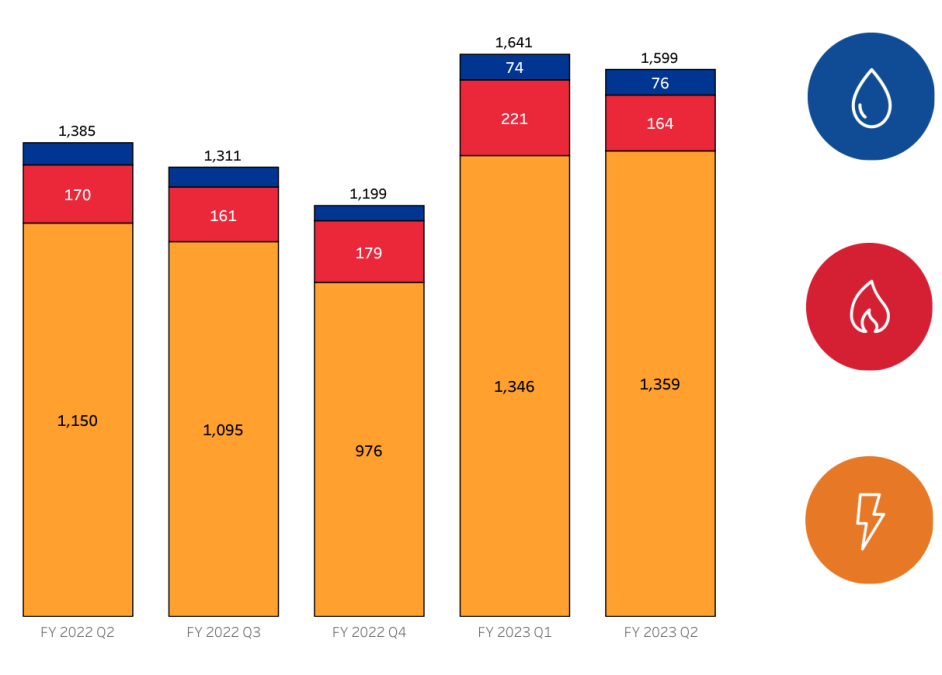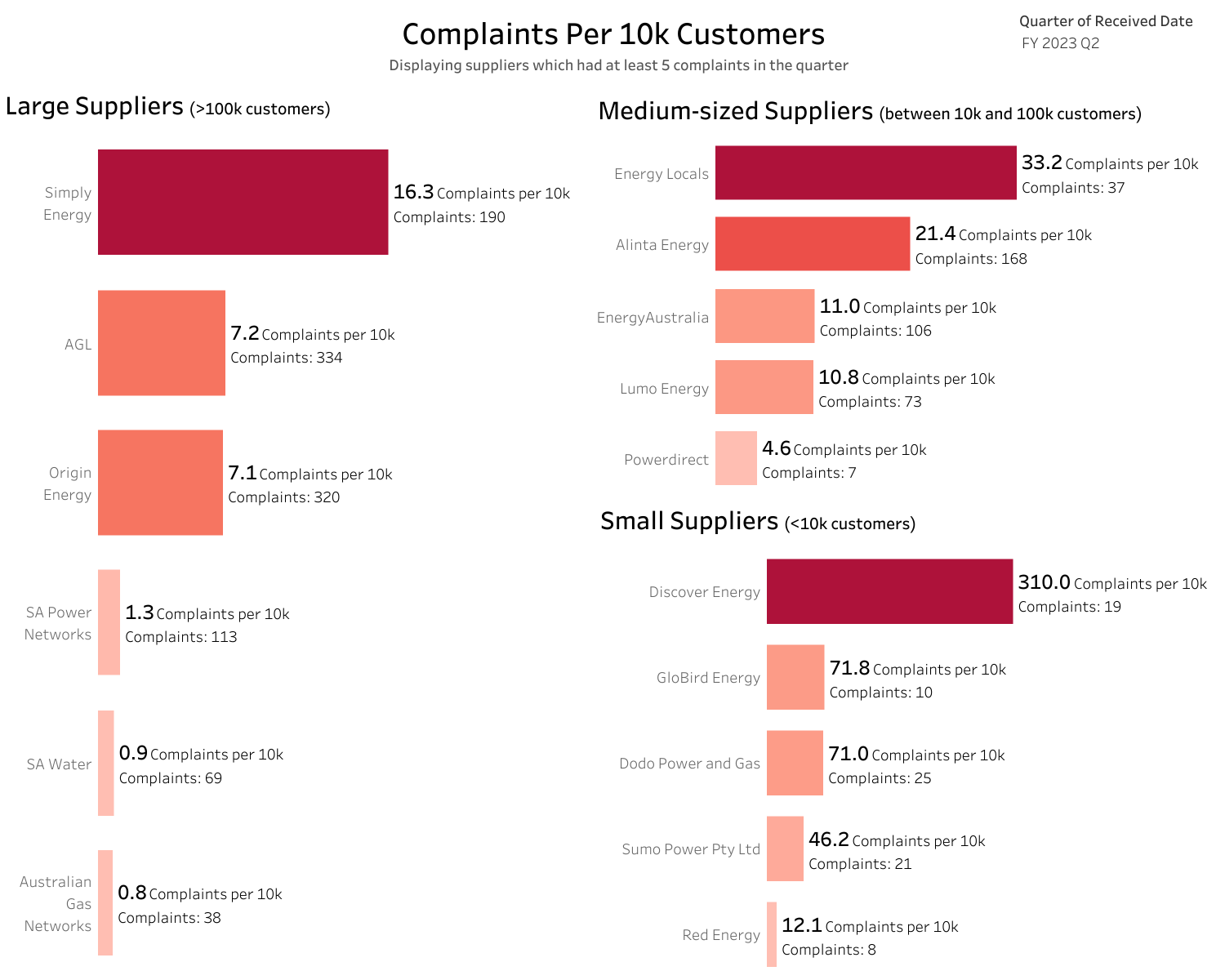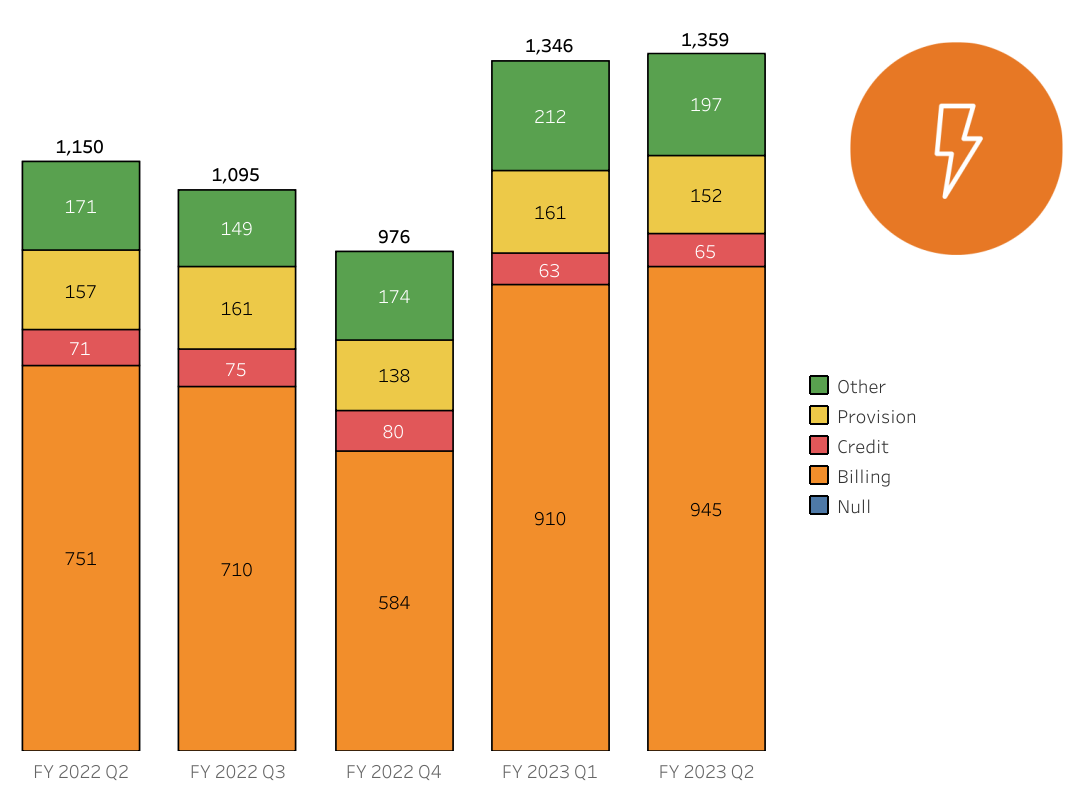EWOSA News - February 2023

- Home
- EWOSA News - February 2023
Welcome to the latest edition of the Energy and Water Ombudsman SA (EWOSA) quarterly newsletter: your one stop shop for emerging consumer trends, hot issues and policy matters.
On this page
From the Ombudsman
Billing issues remain top of the list by volume, with complaints in this category at a level not seen since 2014.
EWOSA also recorded a spike in pricing enquiries between June and August, coinciding with major energy retailers notifying customers of increased prices.
EWOSA also has received higher levels of complaints about customer service and supply issues in the past six months, primarily about lack of response or incorrect advice or information being provided.
Against this trend, credit complaints have declined slightly, and payment difficulty complaints, which often lead to disconnections, are at historically low levels, averaging about 7 complaints per month.
Possible explanations are the current low level of unemployment in South Australia and the flow on from actions taken at the height of the Covid-19 pandemic.
The AER enforced restrictions on disconnections, which saw the number of these complaints fall significantly from May 2020. These restrictions were lifted at the end of June 2021, but payment difficulty complaints remain low.
Consumers have a good reason to remain wary, however. The future of energy prices is always difficult to predict but there are widespread reports of further electricity and gas price rises to come.
That is why we welcome the AER’s recent call for game changing reforms to the way the nation’s energy system approaches vulnerability among consumers. You can read details below.
As always, we want you to know that we are here to help. Please contact us on 1800 665 565 or via our website if you need assistance.
Sandy Canale
Energy and Water Ombudsman SA
Consumer Trends 1


Hot Topics
The AER released a Consumer Vulnerability Strategy on 20 October 2022.
The AER is calling for ‘game-changer’ reforms to the way the nation’s energy system approaches vulnerability among consumers. The strategy – Towards energy equity: A strategy for an inclusive energy market – details 15 specific actions to tackle market complexity, remove barriers to participation, increase protections, and improve affordability for all consumers by reducing retailers’ cost to service customers.
Action 15 is simply titled ‘Advocate for sector-wide ‘game-changer’ reforms. The AER and a cross-sector group are working collaboratively to design the ‘game-changer’ solution and in 2023 intend to commence the broad advocacy to bring the solution to life.
The design group comprises representatives from energy businesses, consumer groups, researchers, government and market bodies. It already has worked through a series of brainstorming exercises on how to bring about change and developed high-level concepts for initial feedback.
Source:
https://www.aer.gov.au/news-release/aer-starts-a-journey-towards-energy-equity
The AER also is exploring ideas for reform of consumer protections in relation to future energy services.
An options paper released on 28 October puts forward for discussion three models that would extend the scope of the energy consumer protection framework beyond the sale of energy to premises. The reasons provided for this approach are that:
- the complexity of the future energy market is likely to be overwhelming for many consumers
- the line between NECF-protected services and non-NECF-protected services will become increasingly blurred
- the AER’s risk assessment to date indicates existing protection frameworks are unlikely to be adequate
- the uptake of new energy products and services is a vital component to realising the benefits of the broader energy system transformation.
The three models are:
- Tiered conditional authorisation framework, with reduced exemption framework
- Authorisation framework based on regulatory principles
- Outcomes-based regulatory framework.
The AER accepted submissions on the options paper until 16 December and will publish its Final Recommendations Paper in August.
Source:
The Australian Energy Market Commission (AEMC) has published a draft report which sets out 20 recommendations and options to accelerate the deployment of smart meters in the National Electricity Market.
It believes that smart meters are foundational to a more connected, modern, and efficient energy system that supports future technologies, services and innovations. It also says that a faster replacement of legacy meters will enable consumers to access the benefits that smart meters can provide.
The Commission invited stakeholder feedback on the draft report. Submissions closed on 2 February, and EWOSA submitted.
Source:
https://www.aemc.gov.au/market-reviews-advice/review-regulatory-framework-metering-services
Consumer Trends 2


Case Studies
Issues: Billing – High – Back bill - Disputed
Utility: Electricity
Customer type: Residential
Case type: Investigation
The issue:
Mr N received a very high backbill and wanted it re-issued on adjusted meter data.
Our review:
We found that for a significant period Mr N’s meter recorded zero consumption and thus he was only charged for supply.
When the meter did start recording, the fluctuations in usage suggested it was recording correctly. If the meter was faulty, the usage would have been high and stayed high.
Resolution:
SA Power Networks declined to provide adjusted meter data.
Mr N’s retailer issued a backbill but, in line with the National Energy Retail Rules, limited the recovery of undercharges to nine months. It also offered Mr N a 24-month payment plan.
Issues: Transfer – delay in transfer
Utility: Gas
Customer type: Business
Case type: Investigation
The issue:
Mr D sought compensation for additional costs incurred by a delay in transfer.
Our review:
Mr D contacted the retailer in June 2022 to establish an account, then called again in September to ask when he could expect his first bill.
The retailer explained that it had failed to transfer his site and failed to notify him as per the requirements of the National Energy Retail Rules.
Resolution:
The retailer paid Mr D the difference between the rates charged by the retailer he was with and what he would have been charged had the transfer gone ahead.
Consumer Trends 3


Customer Corner
A Home Energy Toolkit now available from councils and libraries includes an appliance meter that can measure how much energy each of your appliances uses.
You can also measure the kilowatt (kW) rating of your appliances by checking your meter and doing your own calculations. You will need a pen and paper, a stopwatch or timer to count one minute, and a calculator.
The actual steps you need to take will depend on whether you have a mechanical meter, an electronic meter or a smart meter. Instructions on these steps can be found here.
If you have received an energy or water bill that is higher than you expected, you first need to clarify whether it is correct, whether an error has been made or if there is some kind of problem. First ask yourself these questions.
- Has my usage been estimated?
- Have I used more energy or water recently?
- Did I receive my last bill?
- Were there other fees and charges?
- Has the tariff changed?
You can find more information about these questions as well as how to check your usage here.
Please be mindful of the need to keep cool in hot weather and plan your usage check around that.
Using more air-conditioning and cooling fans in the long, hot days of summer can result in bill shock post-summer.
There are a number of things you can do to help manage these higher bills.
- If you are in payment difficulty, contact your provider and ask to be put on a payment plan
- Shop around. The introduction of the reference price on 1 July 2019 has made it easier to see if you are getting the best deal for your energy needs.
- Check out optimum temperature ranges for heating and cooling appliances. Ideally, set cooling at 25-27 degrees.
- Contact the Energy Advisory Service for advice on the most efficient way to manage energy in the home
- There may be circumstances in which a financial counsellor would be helpful – if so, contact 1800 007 007.
Public Submissions
Consumer Trends 4

The number of complaints per 10,000 customers for each supplier is calculated by dividing the number of complaints received during the quarter by the total number of customers for each supplier, multiplied by 10,000. Large Suppliers are those with over 100,000 customers, Medium-sized Suppliers have between 10,000 and 100,000 customers, Small Suppliers have between 1,000 and 10,000 customers and Very Small Suppliers have less than 1,000 customers. The total number of complaints is also presented for context.



Remember, we are here to help
EWOSA facilitates the prompt resolution of complaints and disputes between consumers of electricity, gas and water services and Members of the Scheme by providing a service to consumers which is free, independent, accessible, fair and informal.
Freecall 1800 665 565
SMS 0488 854 555